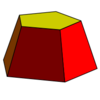Math Flashcards
The concept from economics and game theory addressing dynamics of a non-cooperative game, referring to a situation in which players in a game pursue the optimal strategy while knowing the other players’ strategies, is commonly named after what mathematician and Nobel laureate?
John Forbes Nash Jr.
A posthumous paper by mathematician August Ferdinand Möbius explores the properties of one-sided surfaces via a strip, connected at the ends with a half-twist in the middle. Fellow German mathematician Felix Klein pursued a similar illustration using a theoretical surface that is today, perhaps due to a mistranslation of the original German, most commonly referred to as what type of object?
Bottle
What metric unit of area is roughly equal to 2.47 acres in the U.S. customary system?
Hectare
First proposed in the 1860s and controversial at the time, the scientific laws known as the law of segregation, the law of independent assortment, and the law of dominance are known collectively as a set of laws named after what Augustinian friar?
Gregor Mendel
While a quadrilateral with at least one pair of parallel sides is known in North America as a trapezoid, outside North America it is known as what? The term in question, to North Americans, describes a quadrilateral with no parallel sides (which, outside North America, is simply called a general irregular quadrilateral).
Trapezium
A historically significant mathematics problem, asking, essentially, if a graph on four nodes with seven edges has a “Eulerian path,” was answered in the negative (by Leonhard Euler himself) using the seven bridges of what Prussian city?
Konigsberg
In his Elements, Euclid states five postulates of plane geometry. Four of them are considered fundamental, and apply in many non-Euclidean geometries as well. What geometric term is typically used to name the fifth postulate, despite Euclid not using the word in the postulate’s description?
Parallel
This is the name of the division sign.
Obelus
British mathematician Charles Hinton was known for coining this term, used to describe a shape in the fourth dimension.
Tesseract
What is the term in mathematics for a positive integer that is equal to the sum of its proper divisors (i.e., its divisors not including the number itself)? The first such number is 6 (1+2+3); the next four are 28, 496, 8,128, and 33,550,336.
Perfect number
Among the named properties of equalities in mathematics are the transitive property (if a=b and b=c, then a=c), the symmetric property (if a=b, then b=a), and what other property, which states that any quantity is equal to itself (a=a)?
Reflexive Property
“No three positive integers a, b, and c satisfy the equation a^n + b^n = c^n for any integer value of n greater than 2.” This mathematical statement is associated with British mathematician and Oxford professor Sir Andrew Wiles, but even moreso with what Frenchman?
Pierre de Fermat
99/70 (“Ninety-nine seventieths”) is a frequently used rational approximation for an irrational number that is most commonly referred to as what?
Square root of two
The cube is one of the 5 “platonic solids” or regular these.
Polyhedra
In mathematics, the best-known and most commonly used coordinate system for identifying a point in a plane is named after what man, who invented it in the 17th century?
Rene Descartes
Whose “witch” is pictured here?

(Maria Gaetana) Agnesi
What term can be used in geometry for the region of a circle bounded by an arc of the circle and a chord that connects the endpoints of the arc, and also for the portion of a sphere included between a pair of parallel planes that intersect the sphere? Note, while these are common uses of the term in question in geometry, they are not the most common.
Segmemt




